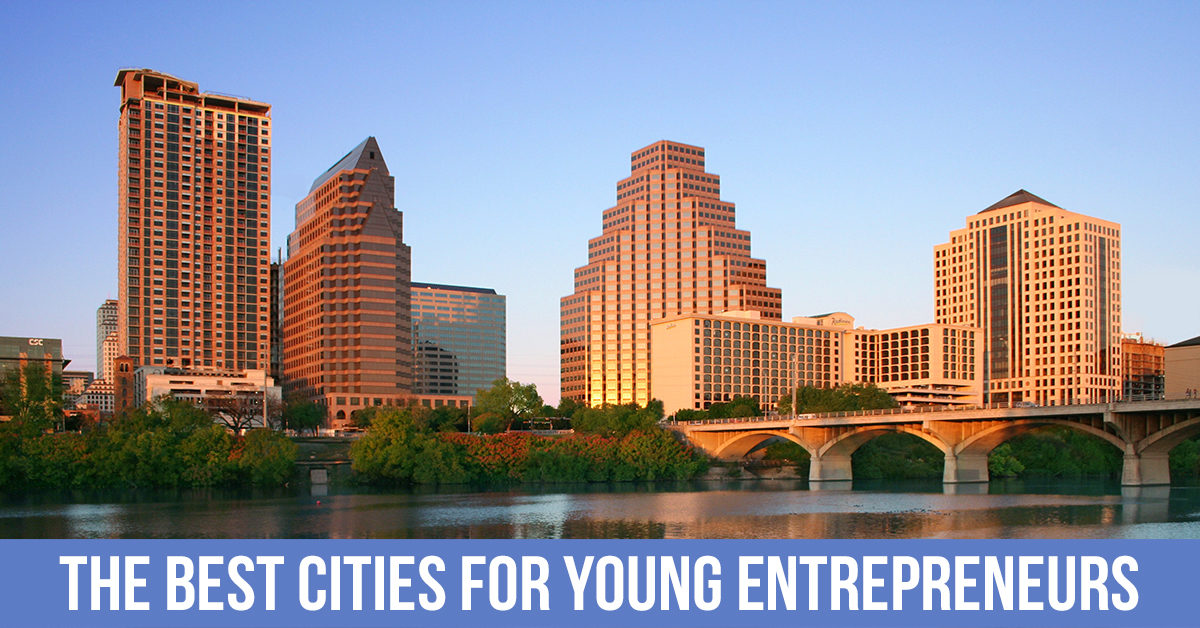The Best Cities for Young Entrepreneurs
Many young entrepreneurs are looking at 2016 as the year to launch the businesses they’ve been dreaming about. With success stories like Slack and Snapchat as inspiration, the entrepreneurial path has seldom been more appealing to those just starting out.
Such optimism is understandable. It’s easier than ever to start a business, to get backers to invest in your dream and to find sources of small-business loans.
Even the workplace communities within cities are changing to accommodate entrepreneurs. Companies like WeWork offer short-term workspaces, reducing the required upfront capital and the headaches caused by managing an office. Young entrepreneurs in some cities have gone even further by combining their living and business spaces and moving into homes populated with other like-minded individuals. The New York Times dubbed these residences “millennial communes.”
Some places are friendlier — and cheaper — than others to launch a business, especially if you’re just starting out in your career. We also factored in the population between ages 25 and 34 and the education level of each city, because a young, local entrepreneurial community is most likely to thrive with more networking and knowledge-sharing opportunities. To find these places, NerdWallet analyzed 181 metropolitan areas in America, parsing data on the local business environment and economy from sources including the U.S. Small Business Administration, the U.S. Census Bureau, the U.S. Bureau of Labor Statistics and more.
Key takeaways
- It’s not all about San Francisco and New York. These two cities are well-known for their entrepreneurial ecosystems, but you can find small-business loans in any city. For small-business loan dollars received per 100,000 residents, Salt Lake City ranks second nationally, and Austin, Texas, was fifth — above eighth-ranked San Francisco and 52nd-ranked New York
- Build around an educated population. Many industries require an increasingly technical and skilled workforce. Entrepreneurs can look to places like Boston and Madison, Wisconsin, for some of the most highly educated populations in the country.
- Lower cost of living means lower operating costs. Many top cities for young entrepreneurs are on the expensive side, but three of the top 10 cities (Austin, Salt Lake City and Midland, Texas) offer costs of living below the national average. By reducing living and office space costs, entrepreneurs have more cash to invest in their growing businesses.
Best cities for young entrepreneurs
1. Austin-Round Rock, Texas
Percent of population ages 25-34: 17.5% (rank: No. 1)
SBA loans per 100,000 residents: $17,692,769 (rank: No. 5)
2. San Francisco-Oakland-Hayward, California
Median earnings: $61,810 (rank: No. 2)
Percent of residents with bachelor’s degree or higher: 45.9% (rank: No. 4)
3. Salt Lake City, Utah
SBA loans per 100,000 residents: $21,590,164 (rank: No. 2)
Percent of population ages 25-34: 16.3% (rank: No. 6)
4. Denver-Aurora-Lakewood, Colorado
SBA loans per 100,000 residents: $14,648,482 (rank: No. 13)
Percent of residents with bachelor’s degree or higher: 40.8% (rank: No. 13)
5. Minneapolis-St.Paul-Bloomington, Minnesota and Wisconsin
SBA loans per 100,000 residents: $15,957,600 (rank: No. 7)
Unemployment rate as of September 2015: 3.1% (rank: No. 10)
6. Seattle-Tacoma-Bellevue, Washington
Median earnings: $55,123 (rank: No. 6)
Percent of population ages 25-34: 16.0% (rank: No. 11)
7. Madison, Wisconsin
Unemployment rate as of September 2015: 2.7% (rank: No. 6)
Percent of residents with bachelor’s degree or higher: 44.7% (rank: No. 8)
8. Midland, Texas
Percent of population ages 25-34: 16.9% (rank: No. 3)
Small businesses per 100 residents: 2.90 (rank: No. 5)
9. Boston-Cambridge-Newton, Massachusetts and New Hampshire
Median earnings: $60,168 (rank: No. 3)
Percent of residents with bachelor’s degree or higher: 45.2% (rank: No. 6)
10. Fargo, North Dakota
Unemployment rate as of September 2015: 2.1% (rank: No. 2)
Percent of population ages 25-34: 16.3% (rank: No. 6)
Best cities for young entrepreneurs, full data
CLICK HERE to see the full data for all 181 metropolitan areas that we looked at.
Top five states for small-business financing
- Utah: $18,299,658 in SBA loans per 100,000 people
- California: $14,488,576 in SBA loans per 100,000 people
- Colorado: $13,127,866 in SBA loans per 100,000 people
- Georgia: $13,126,257 in SBA loans per 100,000 people
- Idaho: $112,960,493 in SBA loans per 100,000 people
Top five places for local business environment
- Montana: 3.49 small businesses per 100 people
- Wyoming: 3.43 small businesses per 100 people
- Vermont: 3.25 small businesses per 100 people
- North Dakota: 3.15 small businesses per 100 people
- District of Columbia: 3.11 small businesses per 100 people
Top five places by earnings
- District of Columbia: $65,595 in median earnings for full-time workers
- Connecticut: $56,466 in median earnings for full-time workers
- Massachusetts: $56,023 in median earnings for full-time workers
- New Jersey: $54,716 in median earnings for full-time workers
- Maryland: $53,906 in median earnings for full-time workers
Methodology
NerdWallet analyzed 181 metropolitan areas in the United States — each area for which cost of living information was available.
The score for each location was determined by analyzing data from the U.S. Small Business Administration, U.S. Census Bureau, U.S. Bureau of Labor Statistics and the Council for Community and Economic Research. Our analysis examined:
Small-business financing, which accounts for 20% of the total score. It’s based on the following metric from the U.S. Small Business Administration (via usaspending.gov):
- SBA loan guarantees per 100,000 people from October 2014 to September 2015 is 20% of the score. A higher rate contributed to a higher score.
Local business environment, which accounts for 25% of the total score. It’s based on the following two metrics from the U.S. Census Bureau’s 2013 County Business Patterns report and the Bureau of Labor Statistics:
- Small businesses per 100 residents is 15% of the score. A higher number contributed to a higher score.
- The unemployment rate as of September 2015 is 10% of the score. A lower rate contributed to a higher score.
Local economy, which accounts for 55% of the total score. It’s based on the following four metrics from the U.S. Census Bureau’s 2014 American Community Survey and the Council for Community and Economic Research:
- The percentage of the total population that is between the ages of 25-34 makes up 15% of the score. A higher percentage contributed to a higher score.
- The percentage of the population age 25 and older with a bachelor’s degree or higher makes up 15% of the score. A higher percentage contributed to a higher score.
- The median earnings of the full-time, year-round civilian employed population age 16 and older makes up 15% of the score. A higher amount contributed to a higher score.
- The cost of living index in the third quarter of 2015 is 10% of the score. A lower rate contributed to a higher score.
This article originally appeared on NerdWallet.


